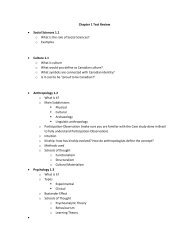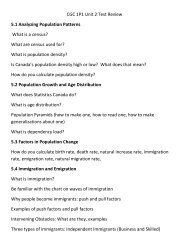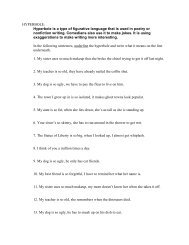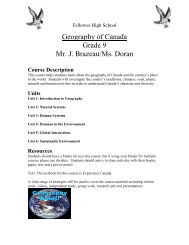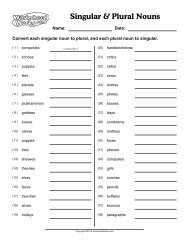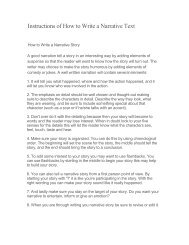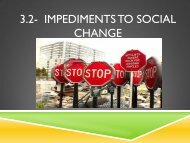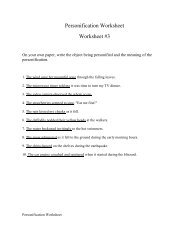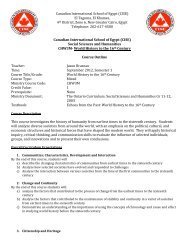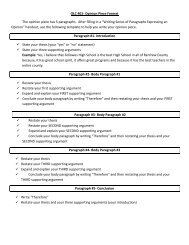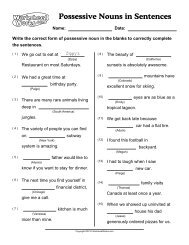CGC 1P1 Exam Review.pdf
CGC 1P1 Exam Review.pdf
CGC 1P1 Exam Review.pdf
- No tags were found...
Create successful ePaper yourself
Turn your PDF publications into a flip-book with our unique Google optimized e-Paper software.
<strong>CGC</strong> <strong>1P1</strong> <strong>Exam</strong> <strong>Review</strong>:Total Marks 135Application / Map Recognition: 20 MarksMultiple Choice: 15 MarksLong Answer: 30 MarksMatching / Definitions: 18 MarksShort Answer: 27 MarksEssay: 25 Marks---------------------------------------------------------------------------------------------------------------------------------------Introductory Unit: Geography Skills- Map of Canada- Provinces/Territories and Capital Cities- Important lines on the Globe- Map standardsUnit 1: Natural Systems- 1.1 Earth in motiono Continental drifto Plate tectonicso Fold mountains- 1.2 Forces of Erosion- 1.3 Weather and Climateo What is the difference?o Precipitation- 1.5 Understanding Climate patternso Arctic climateo Sub-Arctic climateo Pacific climateo Mountain region climate- 2.1 Canada’s landform regionso Canadian Shieldo Great Lakes St Lawrence Lowlandso Appalachianso Interior Plainso Western Cordillerao Inuitianso Arctic- 3.1 Bio-Regionso Tundra bio-regiono Wetlands bio-regiono Woodlot bio-region- 3.2 Understanding Bio-regions- 3.3 Soilso Composition of soilso Two types of soils- 3.4 Flora and Faunao What are both?- 4.1 What is an eco zone?o What eco zone do we live in?o Eco zone boundarieso Transition zoneso Mixed wood plains• Major issues affecting mixedwood plainso Boreal shield eco zone• Major issues affecting Borealshieldo Pacific Maritime eco zone• Resources: clear cuttingo Taiga plains eco zone• Issues surrounding pipelineUnit 2: Human Systems- 5.1 Population patternso Population densityo What is it?o Calculatingo Which areas of Canada have higherlevels of population density? Why?o Is Canada’s population high or low?- 5.2 Population growth and age distributiono Statistics Canadao Age distributiono Population pyramido Dependency load- 5.3 Factors in population changeo Birth rateo Death rateo Population distributiono Natural increase rateo Immigration rateo Emigration rateo Net migration rate- 5.4 Immigration and Emigrationo Push and Pull factors- 6.1 Canadian cultureo What is culture?o What is Canadian culture?o Icons of Canadian culture- 6.2 Cultural diversityo Multiculturalism
o Ethnic originso Visible minoritieso Mother tongue- 6.3 First Nations Peoples and Treatieso Areas in which Aboriginal Peoplesdiffero Contact with Europeanso Signing of the treatieso Royal Proclamation Acto Problems with treaties- 6.4 First Nations Peopleso Cree, Mohawk, Haida- 7.1 Settlement Patternso Farm steado Rural Canadao Long lot systemso Ontario township systemso Strassendorf- 7.2 Rural Canadao Sustainable environmento Where do people work besides farming?o Agri-businesso Urbanizationo Reasons for urbanization- 7.3 Understanding Urban placeso Specific reasons why cities are locatedwhere they areo Urban hierarchy of settlementso Hamlet, village, town, cityUnit 3: Canada’s Industries and Energy- 8.1 Canada’s primary industrieso 3 types of industryo Primary industrieso Fisherieso Forestryo Most important industry in Canada- 8.2 Canada’s Secondary Industrieso Most important Secondary industry inCanadao Canada’s major exportso Location factors- 8.3 Tertiary Industrieso Most important tertiary industry inCanadao Retail sectoro Ribbon developmento Strip mallso Regional mallso Big box storeso Government sector• Federal, Provincial, Municipalo Transportation sector- 8.4 Evaluating energy strategieso Conventional Energyo Renewable Energy• Most commonly used renewableresourceo Nuclear Energy• Benefits and disadvantageso Thermal Energy• Disadvantages and advantageso Hybrid power vehicleso Why Canadian’s use a lot of energyo Hydro-Electricity• Benefits and disadvantageso Clear cutting, selective cutting- 8.5 Climate Changeo Global Warmingo Greenhouse gases• 4 typeso Greenhouse effect• Diagram• Relationship to Global Warmingo Ozoneo Ways Canadians can help reduce/reverseGlobal Warmingo How Canadians have contributed toGlobal Warming- 8.6 Canada’s Global Connectionso How is Canada Globally connected?o Excelled internationally as…x 5o Historical ties• Commonwealtho Economic ties• Importing and exporting• Major trading nation• NAFTAo Political Ties• Peacekeeping• United Nations



